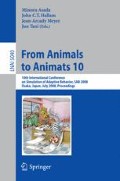Abstract
Recent artificial neural networks for machine learning have exploited transient dynamics around globally stable attractors, inspired by the properties of cortical microcolumns. Here we explore whether similarly constrained neural network controllers can be exploited for embodied, situated adaptive behaviour. We demonstrate that it is possible to evolve globally stable neurocontrollers containing a single basin of attraction, which nevertheless sustain multiple modes of behaviour. This is achieved by exploiting interaction between environmental input and transient dynamics. We present results that suggest that this globally stable regime may constitute an evolvable and dynamically rich subset of recurrent neural network configurations, especially in larger networks. We discuss the issue of scalability and the possibility that there may be alternative adaptive behaviour tasks that are more ‘attractor hungry’.
Access this chapter
Tax calculation will be finalised at checkout
Purchases are for personal use only
Preview
Unable to display preview. Download preview PDF.
References
Maass, W., Natschläger, T., Markram, H.: Real-time computing without stable states: A new framework for neural computation based on perturbations. Computation 14, 2531–2560 (2002)
Hirsch, M.W.: Convergent activation dynamics in continous time networks. Neural Networks 2, 331–349 (1989)
Jaeger, H.: The echo state approach to analysing and training recurrent neural networks. GMD-Report 148, German National Research Institute for Computer Science (2001)
Jaeger, H., Maas, W.: Special issue on echo state networks and liquid state machines. Neural Networks 20, 287–289 (2007)
Rumelhart, D.E., McClelland, J.L.: Parallel Distributed Processing: Explorations in the Microstructure of Cognition. MIT Press, Cambridge (1986)
Hopfield, J.J.: Neural networks and physical systems with emergent collective computational abilities. In: Proceedings of the National Academy of Sciences, USA, vol. 79, pp. 2554–2558 (1982)
Beer, R.D.: The dynamics of active categorical perception in an evolved model agent (with commentary and response). Adaptive Behavior 4(11), 209–243 (2003)
Mathayomchan, B., Beer, R.D.: Center-crossing recurrent neural networks for the evolution of rhythmic behavior. Neural Computation 14, 2043–2051 (2002)
Cohen, M., Grossberg, S.: Absolute stability of global pattern formation and parrallel memory storage by competetive neural networks. IEEE Trans on Syst, Man and Cyber 13, 815–826 (1983)
Strogatz, S.H.: Nonlinear Dynamics & Chaos. Addison-Wesley, Reading (1994)
Jaeger, H., Lukosevicius, M., Popovici, D., Siewart, U.: Optimization and application of echo state networks with leaky-integrator neurons. Neural Networks 20, 335–352 (2007)
Fine, P., Di Paolo, E., Izquierdo, E.: Adapting to your body. In: Costa, F.A.e., Rocha, L.M., Costa, E., Harvey, I., Coutinho, A. (eds.) Ninth European Conference on Artificial Life, pp. 203–212. Springer, Heidelberg (2007)
Williams, H., Noble, J.: Homeostatic plasticity improves signal propagation in continuous time recurrent neural networks. Biosystems 87(2-3), 252–259 (2007)
Buckley, C.L., Bullock, S.: Sensitivity and stability:a signal propagation sweet spot in a sheet of recurrent centre crossing neurons. Submitted to Biosystems (2007)
Izquierdo-Torres, E., Di Paolo, E.: Is an embodied system ever purely reactive? In: Capcarrere, M., Freitas, A., Bentley, P.J., Johnson, C.G., Timmis, J. (eds.) Eighth European Conference on Artificial Life, pp. 252–261. Springer, Heidelberg (2005)
Author information
Authors and Affiliations
Editor information
Rights and permissions
Copyright information
© 2008 Springer-Verlag Berlin Heidelberg
About this paper
Cite this paper
Buckley, C.L., Fine, P., Bullock, S., Di Paolo, E. (2008). Monostable Controllers for Adaptive Behaviour. In: Asada, M., Hallam, J.C.T., Meyer, JA., Tani, J. (eds) From Animals to Animats 10. SAB 2008. Lecture Notes in Computer Science(), vol 5040. Springer, Berlin, Heidelberg. https://doi.org/10.1007/978-3-540-69134-1_11
Download citation
DOI: https://doi.org/10.1007/978-3-540-69134-1_11
Publisher Name: Springer, Berlin, Heidelberg
Print ISBN: 978-3-540-69133-4
Online ISBN: 978-3-540-69134-1
eBook Packages: Computer ScienceComputer Science (R0)

